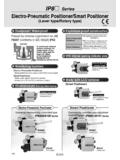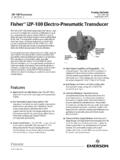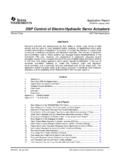Transcription of 35mm YASHICA ELECTRO RANGE-FINDER MANUAL
1 Page 1 of 1 35mm YASHICA ELECTRO RANGE-FINDER MANUAL This Document was Updated on January 2, 2005 This Update adds Support to Questions Most Frequently Asked Since the Last Revision Entire Contents 1999 2005 by Joe Marcel Wolff All Rights Reserved. Copies May be Printed Out for Personal Use Page 2 of 2 35mm YASHICA ELECTRO RANGE-FINDER MANUAL KEY STEPS FOR AUTOMATIC PHOTOGRAPHY WITH THE G SERIES 1. Load and Check Battery 2. Unlock Shutter Release Button 3. Load Film 4. Set ASA Film Speed 5. Set Camera for Automatic Operation 6. Select Appropriate Exposure Symbol 7. Focus 8. Control Exposure -- using Over - Under !
2 Page 3 of 3 BATTERY LOADING AND CHECKING 1. Unscrew the Battery Compartment Cover with the edge of a coin. 2. Mercury battery sales are prohibited. Therefore use of the YASHICA Guy Pro Battery Adapter is suggested to replace the original types Mallory TR 164, Eveready E164 or discontinued Duracell PX 32 Alkaline battery. 3. When the camera will not be in use for a while, be sure to remove the battery and store it in a dry cool place, to avoid a battery leak that could ruin your camera. 4. Check battery before picture-taking. Press Battery Check Button. If the green light comes on in the Film Exposure Counter, the battery power is sufficient. If not, the battery should be replaced. FILM LOADING (Always load in subdued light) 1.
3 Pull out Film Rewind Knob, and Back Cover will pop open. The Film Exposure Counter is automatically set at "S" (Start). 2. Place a 35mm film cassette into film chamber and push down the Film Rewind Knob. 3. Insert film leader into Take-up Spool and advance film with the Film Advance Lever, making sure the perforations properly engage the sprocket teeth. Close Back Cover. 4. Gently wind the film rewind crank-handle on Film Rewind Knob, until a slight resistance is felt, to remove film slack. 5. Advance film, then press shutter Release Button, and repeat until the figure "1" appears in the Film Exposure Counter. 6. Make sure the film is properly loaded. As you advance the film, the Film Rewind Knob should rotate counter-clockwise. ASA FILM SPEED SETTING Align the mark on the ASA Film Speed Index Setting Ring with the ASA / ISO rating of the film in use.
4 The Film rating is shown on the box or the instructions that come with the film. (DIN film speed rating conversion table is given inside the camera). SHUTTER RELEASE BUTTON To lock the Shutter Release Button, align the mark on the Shutter Release LOCK with the letter "L". To unlock, give Lock turn clockwise. When camera is not in use, the shutter should not be left cocked, and the Shutter Release Lock should be in the locked position. Page 4 of 4 AUTOMATIC OPERATION For automatic operation, set the Exposure Control Ring to AUTO position. (With the use of exclusive Lens Shade provided with the GT model, the Exposure Control Ring will lock at the AUTO position.) EXPOSURE SYMBOLS Select the appropriate Exposure Symbol and set it opposite the mark by turning the Aperture Ring.
5 SUN or CLOUD symbol - for outdoor photography. WINDOW symbol - for indoor and night photography. This should bring you close to the correct exposure with 100 ASA / ISO film. Use the Over - Under lamps to zero in. FOCUSING 1. Sight through the Viewfinder and turn the Focusing Ring until the two images in the center focusing area form one clear image. 2. Compose picture within the bright frame that, during focusing, in particular at short distances, moves diagonally for automatic parallax correction. EXPOSURE CONTROL 1. The RED and YELLOW warning arrows in the Viewfinder and on the camera top are actuated when the Film Advance Lever is wound and the Shutter Release Button is pressed in half way. Practice this without film in the camera. 2. The absence of both arrows signifies hand-held photography is possible.
6 All you need do for a perfect picture is FOCUS and PRESS the Shutter Release Button down all the way. The appearance of the RED arrow ( when the Shutter Release Button is half - pressed ) signifies too much light. Turn the aperture Ring in the direction of the arrow until it disappears. If it fails to disappear, a neutral density filter should be used and the ASA Film speed Setting Ring reset accordingly. If the original setting was ASA 100, reset to ASA 25 when an ND4 Neutral Density filter is used. With The MG-1 and the GL models, do not reset the ASA. The Electronic Exposure Page 5 of 5 Control [EEC] in the lens mount will correct for this because it "sees" through the filter in place.
7 3. The chart below is a convenient guide to resetting the ASA Index on your camera to compensate for the filter in use. Guide numbers that are shown on the film package are now generally displayed as ISO numbers. These are identical to the earlier ASA rating Index. Convert ASA / ISO Index to FILTER FACTOR Colour or Neutral Density Filter Factor ASA 2 3 4 5 8 12 16 32 1000 650 500 400 320 250 200 125 80 64 40 800 500 400 320 250 200 160 100 64 50 32 650 400 320 250 200 160 125 80 50 40 25 500 320 250 200 160 125 100 64 40 32 20 400 250 200 160 125 100 80 50 32 25 16 320 200 160 125 100 80 64 40 24 20 12 250 160 125 100 80 64 50 32 20 16 10 200 125 100 80 64 50 40 25 16 12 8 160 100 80 64 50 40 32 20 12 10 6 125 80 64 50 40 32 25 16 10 8 5 100 64 50 40 32 25 20 12 8 6 4 80 50 40 32 25 20
8 16 10 6 5 3 64 40 32 24 20 16 12 8 5 4 50 32 25 20 16 12 10 6 4 3 2 40 25 20 16 12 10 8 5 3 YASHICA Guy has rounded off results to the nearest ASA setting Page 6 of 6 EXPOSURE INDICATORS The appearance of the YELLOW arrow signifies too little light for hand-held photography, since the exposure speed will be slower than 1/30 second. Turn the Aperture Ring in the direction of the arrow until it disappears. If it fails to disappear, use a tripod. ( YASHICA convertible Grip/Tripod ST-7 is handy to lean up against a wall or post for support ). Whether the YELLOW arrow disappears or not, the precise exposure speed will be determined and set automatically to a maximum of 30 seconds.
9 CONTROL OF SHUTTER SPEED The ELECTRO Exposure control system is of the Aperture Priority type. You select the lens opening and it sets the shutter speed for the correct exposure. This normally works out very well You can however overcome this and control the shutter speed, for sporting events for example. When you understand the relationship between the aperture stops and the percentage of light between them, it actually becomes quite simple to select the shutter speed best suited for your shots. Each stop on the lens barrel, namely, 16 - 11 - 8 - - 4 - - 2 - represents a 100% change from the adjoining setting. As the numbers get larger, the amount of light transmitted by the lens becomes LESS, because this number is NOT the size of the lens opening but is the ratio of the size of the lens opening [aperture] to the focal length of the lens.
10 With this in mind, it is not difficult to follow the procedure. In daylight photography, set the lens opening to maximum for the sake of simplicity. This is on the 'G' series. Now slowly press the shutter release button until you see the red over exposure lamp. Then adjust the lens opening until both the red and yellow lamps are out. At this point your camera is set for the correct exposure with the shutter set at 1/500th sec. If you wish to cut the shutter speed in half to 1/250th second for the sake of greater depth of focus, move the indicated lens opening on the barrel to the next 100% smaller aperture setting. For example if the lamp went out at , decrease the lens opening by 100% to Obviously you can move from one mid point to the next. To obtain an exposure of 1/125th second, you would move the lens by two increments to 11.







